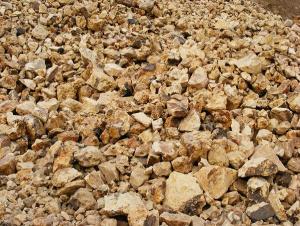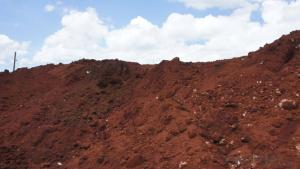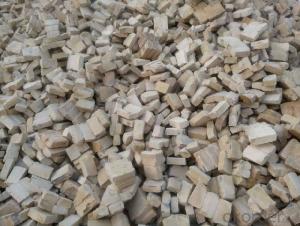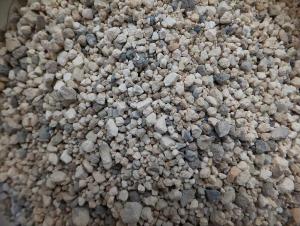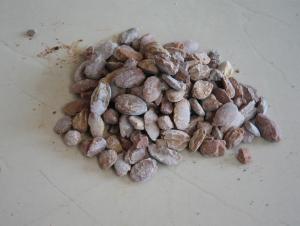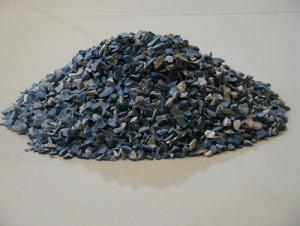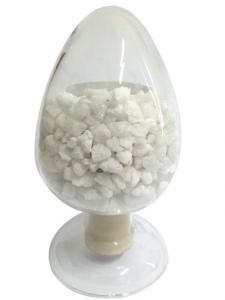Different Sizes and Special Shape Bauxite Fire of CNBM in China
- Loading Port:
- Tianjin
- Payment Terms:
- TT OR LC
- Min Order Qty:
- 16 m.t.
- Supply Capability:
- 10000000 m.t./month
OKorder Service Pledge
OKorder Financial Service
You Might Also Like
Different Sizes and Special Shape Bauxite of CNBM in China
1.Structure of Calcined Bauxite Description
Bauxite (aluminous soil; Bauxite) is also called the alumina or bauxite, main ingredients are alumina, hydrated alumina containing impurities, is an earthy mineral. White or gray, brown and yellow or light red by iron. From 4 to 3.9 g/cm3 density, hardness, 1 ~ 3 is not transparent, very brittle. Very difficult to melt. Insoluble in water, soluble in sulfuric acid, sodium hydroxide solution. Mainly used for aluminium, refractory material.
2.Main Features of the Calcined Bauxite
Calcined bauxite is one of the principal ore of aluminum. Calcined bauxite contains hydrous aluminum oxides and aluminum
hydroxides, formed through the laterization of aluminous rocks in tropical and subtropical areas .Calcined bauxite is obtained by calcining (heating)superior grade bauxite at high temperature (from 85OC to 1600C) .This removes moisture there. By increasing the alumina content,compared to an alumina content of about 57%to 58% in raw bauxite, calcined bauxite has an alumina content of 84%to88%.The heating is carried out in rotary kilns.
3.Main usage of the Calcined Bauxite
(1) aluminium industry. Used in national defense, aerospace, automotive, electronics, chemical industry, daily necessities, etc.
(2) precision casting. Alumina clinker made after the mould precision casting processed into fine powder. Used in military industry, aerospace, communications, instrumentation, machinery and medical equipment department.
4. Calcined Bauxite Images

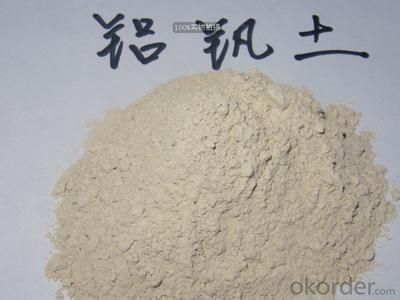
5. Calcined Bauxite Specification
ITEM | SK-32 | SK-34 | SK-36 | SK-38 |
Al2O3(%)Min | 35 | 38 | 48 | 65 |
Fe2O3(%)Max | 3.00-4.00 | 2.50 | 2.00 | 2.00 |
0.2Mpa Refractoriness under load (°C) Min | 1300 |
1350
|
1450
|
1500
|
Apparent porosity(%) | 22-26 | 20-24 | 20-23 | 20-22 |
B.D(g/cm³)Min | 2.05-2.10 | 2.10-2.2 | 2.25-2.35 | 2.40-2.50 |
Cold crushing strength Mpa | 22 | 25 | 45 | 50 |
6.FAQ of Calcined Bauxite
1). Q: Are you a factory or trading company?
A: We are a factory.
2). Q: Where is your factory located? How can I visit there?
A: Our factory is located in ShanXi, HeNan, China. You are warmly welcomed to visit us!
3). Q: How can I get some samples?
A: Please connect me for samples
4). Q: Can the price be cheaper?
A: Of course, you will be offered a good discount for big amount.
- Q:How to deiron refractory?
- Our company uses magnetic separation method.
- Q:What is the appropiate thickness if fire resistant time for ultra thin steel structure coating is 2.5 hours?
- According to the "code for fire protection design of tall buildings", the fire resistance time of the component is at the first level: 3 hours, beam: 2 hours, floor: 1.5 hours;if fire resistance level is level the requirement for time of fire resistance component is the column: 2.5 hours, beam: 1.5 hours, floor: 1 hours. For fire resistant coating, fire resistance time for ultra-thin fire retardant coating is shorter than 1.5 hours. If the time exceeds 1.5 hours, thick fire resistive coating should be used. Steel structure can adopt surrounding concrete or brick, fireproof coating, fireproof board coating and composite structure for its fire resisitance. Fire resisitance board can be divided into thick fire protection plate and thin plate, the thickness of the plate thickness of the fire is between 20 ~ 50mm, mainly includes calcium silicate fireproof board and expansion boring stone fire board, the main varieties are KB board, CF; thin fireproof plate is between 6 ~ 15mm thick, the main varieties include enforced short fiber cement plate, ordinary enforced fiber silicate calcium board and glass cloth reinforced inorganic board. As is known to all, steel structure usually will lose bearing capacity usually in 450 to 650 degree, leading to deformation, steel column and beam bending, and be no longer usable at last. Generally fire resistant limit of unprotected steel stucture is about 15 minutes. 1.5 hours;if fire resistance level is level the requirement for time of fire resistance component is the column: 2.5 hours, beam: 1.5 hours, floor: 1 hours. Steel structure an use surrounding concrete (or masonry), fire retardant coating, fire retardant plate and compround structure to achieve the required refractory limit. Hope my answer will help you.
- Q:How to make fire resistant materials for building stoves
- Legend of the old version has been upgraded, or can not enter the server, is not legend stopped?
- Q:What a blast furnace refractories generally?
- refractories for blast furnace include carbon brick and silicon-aluminum refractory. BF carbon brick inlcudes half-carbon charcoal bricks, microporous charcoal brick, ultra porous charcoal bricks, graphitic brick and mould pressing charcoal brick. tiles and molded graphite small charcoal bricks. I hope my answers above are helpful to you and your ideal anwers.
- Q:What does the function of SiC for refractories?
- Anti-acid corrosion anti-skinning
- Q:Where is the sizing nozzle for refractories? Just enter the line, master into!
- This is the use of steel tapping water procedures inside!!
- Q:Is the linear change on reheating the same as heating permanent linear change of refractory material?
- “+”represents expansion. the afterexpansion and aftercontraction after cooled to be at room temperature. The change may significantly damage the masonry of thermal kiln. There are regulations on the linear change on reheating of common refractory material in the national standard. Some physical chemical changes may continue. It is defined as the change from being heated to the specified temperature of refractory material sample. Heat preserving for a while till afte cooling to be at room temperature, then the residual will expand or contract in its length, heat preservation for a while, organization vitrification, the irreversible changes of its length refers to heating the firing refractory to be at high temperature, so as to make the volume of refractory materials expand or contract, due to the influence of uneven temperature or lack of time, otherwise it will cause the deformation of the refractory ball and make this indicator within standard even reach smaller value, so firing control must be strengthened in product production. But it is should not be too high. For refractory materials with same chemical composition, the linear change on reheating is produced in the heating process. Properly increasing sintering temperature and prolonging the holding time is an effective process measures, make its firing inadequate. When subjected to high temperature, it can reduce the thermal shock resistance. Minus sign "-" represents contraction. The permanent line rate refers to heating the fire refractory ball to the specified temperature. Linear change on reheating, also known as residual linear change, is an important indicator to assess the quality of refractory in the long time use. To control the permanent line rate within the standard or reach the minimum value.
- Q:How to distinguish the construction fire-proof material rating?
- According to national standard GB8624-97,combustion performance of building materials are divided into the following levels: Class A: Incombustible building material: Material that almost never burn. Class B1: Nonflammable building material: Nonflammable materials have good effect of flame resistance. In case of fire it in the air or at high temperature it is difficult to catch fire and spread, and when the fire source is removed, the combustion can stop immediately. Class B2: Combustible?building?material: Combustible materials have good effect of flame resistance. In case of open fire in the air or at high temperature, it will immediately burst into flames and spread the fire quickly, such as wooden column, timber roof truss, wooden stairs, etc. Class B3: Flammable building material: No flame-retardant effect, highly flammable, high risk of fire. According to national standard, the fire?rating of PVC floor must be class B1.
- Q:How to determine the fire resistance rating of the aluminium-plastic?panel?
- The fire resistance rating of the aluminium-plastic?panel is determined by two indicators, namely national compulsory standard of GB8624 "Building Materials Combustion Performance Grading Method ", and GB/T17748 "Aluminium-plastic?Composite Panel National Standard" . Classifications of combustion performance of building materials in our country are as follows: A class: Incombustible building materials; B1 class: Flame-retardant building materials; B2 class: combustible building material; B3 class: flammable building materials. The fire resistance rating of the aluminium-plastic composite panel shuld be no less than B1 class. 1. Detection indexes and requirements of fireproof aluminum-plastic composite panel (B1 class): (1) Conduct the test according to GB/T8625-88, the average leftover length of each test specimen should be more than 150mm, (any test piece should have leftover length), and the maximum average flue gas temperature of each test should be no more than 200 ℃; (2) Conduct the test according to GB/T8626-88, flame hight indicators.
- Q:how does the fire endurance of first rate fire resistant window?
- class A window not less than 1.5 hours, class B window not less than 1 hours, Class C window not less than 0.5 hours.
1. Manufacturer Overview |
|
|---|---|
| Location | |
| Year Established | |
| Annual Output Value | |
| Main Markets | |
| Company Certifications | |
2. Manufacturer Certificates |
|
|---|---|
| a) Certification Name | |
| Range | |
| Reference | |
| Validity Period | |
3. Manufacturer Capability |
|
|---|---|
| a)Trade Capacity | |
| Nearest Port | |
| Export Percentage | |
| No.of Employees in Trade Department | |
| Language Spoken: | |
| b)Factory Information | |
| Factory Size: | |
| No. of Production Lines | |
| Contract Manufacturing | |
| Product Price Range | |
Send your message to us
Different Sizes and Special Shape Bauxite Fire of CNBM in China
- Loading Port:
- Tianjin
- Payment Terms:
- TT OR LC
- Min Order Qty:
- 16 m.t.
- Supply Capability:
- 10000000 m.t./month
OKorder Service Pledge
OKorder Financial Service
Similar products
New products
Hot products
Hot Searches
Related keywords
